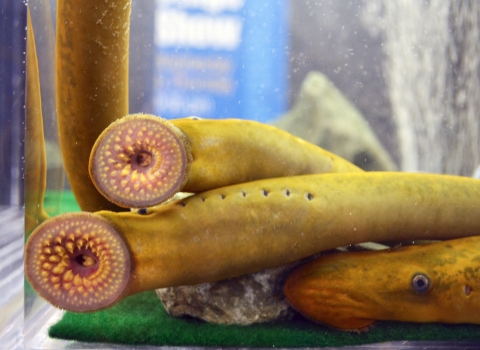Q: What is the Louisiana pinesnake?
A. The Louisiana pinesnake (Pitouphis ruthveni) is an egg-laying, non-venomous constrictor of western and central Louisiana and eastern Texas. They generally are found in sandy, well-drained soils and open pine forests such as longleaf-pine savanna. They live largely underground and rely on the Baird’s pocket gopher as an essential part of their habitat. Baird’s pocket gophers not only create the burrow systems in which the Louisiana pinesnake are most frequently found but also serve as a major source of food for the snake. The Service listed the Louisiana pinesnake as threatened under the Endangered Species Act (ESA) on April 6, 2018, and published a species-specific 4(d) rule on February 27, 2020.
Q: What are the main threats to the Louisiana pinesnake?
A. The Louisiana pinesnake was listed as threatened primarily due to the threat of habitat loss and degradation. Most of the longleaf pine savanna that serves as the snake’s habitat had been reduced by the 1930s, and it rarely regenerated naturally. The remaining natural longleaf pine ecosystem across the species range is fragmented and greatly reduced from its historic extent.
Q: What action is the U.S. Fish and Wildlife Service taking?
A. The Service is proposing to designate a total of 209,520 acres of critical habitat for the Louisiana pinesnake in six units in Bienville, Grant, Rapides and Vernon parishes in Louisiana and Angelina, Jasper and Newton counties in Texas. Detailed information on critical habitat units can be found at the following website:
https://ecos.fws.gov/ServCat/Reference/Profile/145928
Q: How does the ESA define critical habitat?
A. The ESA defines critical habitat as the specific geographic areas that contain features essential to the conservation of an endangered or threatened species that may require special management and protection. Critical habitat may also include areas that are not currently occupied by the species but will be needed for its recovery.
Q: How does the Service determine what areas to designate as a critical habitat?
A. Within areas occupied by the species, biologists consider physical or biological features needed for life processes. These include:
Space for individual and population growth and for normal behavior.
Cover or shelter.
Food, water, air, light, minerals, or other nutritional or physiological requirements.
Sites for breeding and rearing offspring.
Habitats that are protected from disturbances or are representative of the historical, geographical, and ecological distributions of a species.
After considering occupied areas, biologists consider unoccupied areas that may be essential for the conservation of the species.
Q: What is the proposed habitat for the Louisiana pinesnake?
A. The areas proposed for critical habitat are in Bienville, Grant, Rapides and Vernon parishes in Louisiana and Angelina, Jasper and Newton counties in Texas. The areas proposed for critical habitat include 65% federal lands, 0.1% state and 35% private ownership. There are no lands under Tribal ownership in the proposed designation.
Five of the six units are currently occupied by the Louisiana pinesnake. The unoccupied unit is within the historic range but is not currently occupied. All occupied and unoccupied areas are essential for the snake’s recovery.
Q: Did the Service consider operations at Fort Polk and Peason Ridge during the designation of the critical habitat?
A. During the development of the proposed critical habitat, the Service worked closely with federal and state partners within the area of potential designation. The Service received comments from the U.S. Army concerning the potential impact of designating critical habitat on operations on Fort Polk and Peason Ridge. The Service met with the post leadership and provided information on the designation process, including exemptions and exclusions.
Q: What is the draft economic analysis on this proposed action and why was it done? What did it find?
A: As required by the ESA, the Service assessed the economic impacts of this proposed critical habitat designation. The draft economic analysis indicates that economic and other impacts of the critical habitat designation are not likely to be significant, and they will be outweighed by the benefits of the designation.
Q: How do I submit comments on this proposal?
A. For directions on how to submit comments, visit the Federal eRulemaking Portal at http://www.regulations.gov. In the Search box, enter FWS-R4-ES-2021-0166, which is the docket number for this rulemaking. Comments must be received by December 5, 2022. We must receive requests for a public hearing, in writing, at the address shown below by November 21, 2022.
FOR FURTHER INFORMATION CONTACT: Brigette Firmin, Deputy Field Supervisor, U.S. Fish and Wildlife Service, Louisiana Ecological Services Field Office, 200 Dulles Drive, Lafayette, LA 70506; telephone 337-291-3100.


